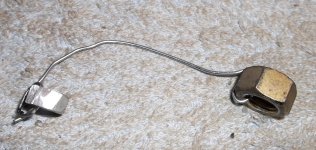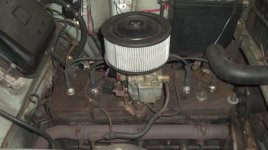Credit for this procedure goes to wsa111, who recommended it to me, and it worked perfectly on a '59 Nash Flathead.
If the need arises to find true TDC using a piston-stop on an assembled flathead engine, it can be done in this way:
Secure a 1/4" nut to a malleable piece of wire. This can then be carefully inserted into the #1 spark plug opening, and guided to the edge of the piston bore. Keep the position of the nut stationary during the procedure. Rotate the engine till the nut binds between the piston top and the head. Mark the damper. Rotate the engine in the opposite direction, and mark the damper once it's at the stop. The center-point between these marks is true TDC. Mark the damper accordingly.
TIPS:
1) Rounding off the outer hexes of the 1/4" nut with a grinder will allow it to be removed thru the SP hole without the hex edges hanging up on the SP threads in the head. Use a steel nut, incase it gets detached from the wire and has to be retrieved with a magnet.
2) Use wire soft enough to A) get 2 good tight wraps around the nut and B) soft enough to bend as it's fed sideways into the chamber. I used a large paper clip. The nut needs to be tightly secured to the wire so that it does not shift in the wire during the procedure.
3) Tightly securing another larger nut on the opposite end makes a good anchor-point for holding the wire while the procedure is being performed. Remember, the chamber is sloped above the piston, if the wire or internal nut shifts during the procedure, repeat it to verify results are accurate.

If the need arises to find true TDC using a piston-stop on an assembled flathead engine, it can be done in this way:
Secure a 1/4" nut to a malleable piece of wire. This can then be carefully inserted into the #1 spark plug opening, and guided to the edge of the piston bore. Keep the position of the nut stationary during the procedure. Rotate the engine till the nut binds between the piston top and the head. Mark the damper. Rotate the engine in the opposite direction, and mark the damper once it's at the stop. The center-point between these marks is true TDC. Mark the damper accordingly.
TIPS:
1) Rounding off the outer hexes of the 1/4" nut with a grinder will allow it to be removed thru the SP hole without the hex edges hanging up on the SP threads in the head. Use a steel nut, incase it gets detached from the wire and has to be retrieved with a magnet.
2) Use wire soft enough to A) get 2 good tight wraps around the nut and B) soft enough to bend as it's fed sideways into the chamber. I used a large paper clip. The nut needs to be tightly secured to the wire so that it does not shift in the wire during the procedure.
3) Tightly securing another larger nut on the opposite end makes a good anchor-point for holding the wire while the procedure is being performed. Remember, the chamber is sloped above the piston, if the wire or internal nut shifts during the procedure, repeat it to verify results are accurate.

Last edited:

